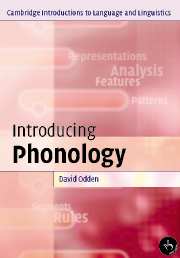Book contents
- Frontmatter
- Contents
- About this book
- Acknowledgments
- A note on languages
- List of abbreviations
- 1 What is phonology?
- 2 Phonetic transcriptions
- 3 Allophonic relations
- 4 Underlying representations
- 5 Interacting processes
- 6 Feature theory
- 7 Doing an analysis
- 8 Phonological typology and naturalness
- 9 Abstractness and psychological reality
- 10 Nonlinear representations
- Glossary
- References
- Index of languages
- General Index
3 - Allophonic relations
Published online by Cambridge University Press: 05 June 2012
- Frontmatter
- Contents
- About this book
- Acknowledgments
- A note on languages
- List of abbreviations
- 1 What is phonology?
- 2 Phonetic transcriptions
- 3 Allophonic relations
- 4 Underlying representations
- 5 Interacting processes
- 6 Feature theory
- 7 Doing an analysis
- 8 Phonological typology and naturalness
- 9 Abstractness and psychological reality
- 10 Nonlinear representations
- Glossary
- References
- Index of languages
- General Index
Summary
KEY TERMS
allophone
phoneme
complementary distribution
contrast
distinctiveness
PREVIEW
This chapter begins the analysis of phonological processes. You will:
learn of predictable variants of basic sounds in English
learn about the concepts “phoneme” and “allophone”
discover that similar relations between sounds exist in other languages
begin to learn the general technique for inducing phonological rules from data that come from a language which you do not know
be introduced to the formalization of phonological rules
While a phonetically accurate representation of pronunciation is useful to phonology, the focus of phonology is not transcription of words, but is rather the mental rules which govern the pronunciation of words in a given language. Certain facts about pronunciation simply cannot be predicted by rule, for example that in English the word sick is pronounced [sιk] and sip is pronounced [sιp]. Hence one fundamental component of a language is a lexicon, a list of words (or morphemes – parts of words), which must provide any information which cannot be predicted by rules of the language. However, much about the pronunciation of words can be predicted. For example, in the word tick the initial voiceless consonant t is phonetically aspirated, and is phonetically transcribed [thιk]. This aspiration can be demonstrated visually by dangling a tissue in front of the mouth when saying the word: notice that when you pronounce t, the tissue is blown forward.
- Type
- Chapter
- Information
- Introducing Phonology , pp. 43 - 66Publisher: Cambridge University PressPrint publication year: 2005



